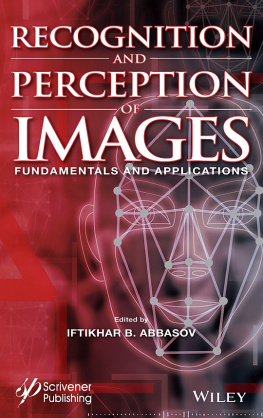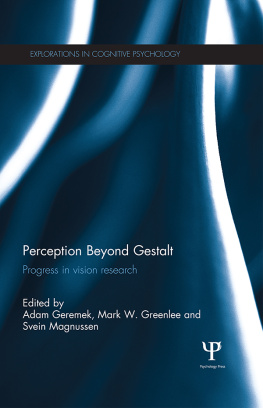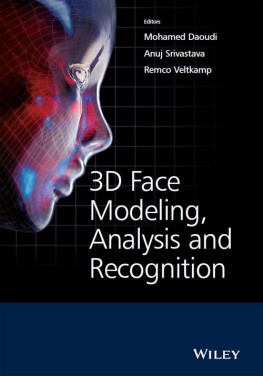The Oxford Handbook of Face Perception
The Oxford
Handbook of Face Perception
Edited by
Andrew J. Calder
Gillian Rhodes
Mark H. Johnson
and
James V. Haxby


Great Clarendon Street, Oxford OX2 6DP
Oxford University Press is a department of the University of Oxford.
It furthers the Universitys objective of excellence in research, scholarship,
and education by publishing worldwide in
Oxford New York
Auckland Cape Town Dar es Salaam Hong Kong Karachi
Kuala Lumpur Madrid Melbourne Mexico City Nairobi
New Delhi Shanghai Taipei Toronto
With offices in
Argentina Austria Brazil Chile Czech Republic France Greece
Guatemala Hungary Italy Japan Poland Portugal Singapore
South Korea Switzerland Thailand Turkey Ukraine Vietnam
Oxford is a registered trade mark of Oxford University Press
in the UK and in certain other countries
Published in the United States
by Oxford University Press Inc., New York
Oxford University Press, 2011
Materials () in this book prepared by the authors as part of their
official duties as U.S. government employees are not covered by copyright.
The moral rights of the authors have been asserted
Database right Oxford University Press (maker)
First published 2011
All rights reserved. No part of this publication may be reproduced, stored in a retrieval system, or transmitted, in any form or by any means, without the prior permission in writing of Oxford University Press, or as expressly permitted by law, or under terms agreed with the appropriate reprographics rights organization. Enquiries concerning reproduction outside the scope of the above should be sent to the Rights Department, Oxford University Press, at the address above
You must not circulate this book in any other binding or cover
and you must impose the same condition on any acquirer
British Library Cataloging in Publication Data
Data available
Library of Congress Cataloging in Publication Data
Library of Congress Control Number: 2011920651
Typeset by Glyph International, Bangalore, India
Printed in China
on acid-free paper by
Asia Pacific Offset
ISBN 9780199559053
10 9 8 7 6 5 4 3 2 1
Whilst every effort has been made to ensure that the contents of this book are as complete, accurate and up-to-date as possible at the date of writing, Oxford University Press is not able to give any guarantee or assurance that such is the case. Readers are urged to take appropriately qualified medical advice in all cases. The information in this book is intended to be useful to the general reader, but should not be used as a means of self-diagnosis or for the prescription of medication.
Preface
The human face is unique among social stimuli in conveying such a variety of different characteristics. A persons identity, sex, race, age, emotional state, focus of attention, facial speech patterns, and attractiveness are all detected and interpreted with relative ease from the face. Humans also display a surprising degree of consistency in the extent to which personality traits, such as trustworthiness and likeability, are attributed to faces. The chapters that follow are concerned with the scientific study of these different aspects of face perception. The idea for the book was conceived by two of the editors (Andy Calder and Gill Rhodes) during Calders visit to the University of Western Australia. An edited book on face perception was on the cards, but both agreed that the area was unlikely to benefit a great deal from yet another edited volume focusing on one aspect of face research. In light of the increasing volume of studies addressing multiple aspects of face perception a handbook format was a surprising omission from the literature. This required a greater range of editorial expertise, and Mark Johnson and Jim Haxby were recruited to the team. Three years later, we are delighted to present The Oxford Handbook of Face Perception.
In contrast to other areas of psychological study, such as memory, language, and attention, the study of face perception was a minority interest during the early years of cognitive psychology, and the topic received little or no attention in early cognitive psychology textbooks. One potential reason why is illustrated by an anecdote from one of contributors, Vicki Bruce. Shortly after embarking on her PhD addressing face recognition, most likely one of the first, a highly respected vision scientist at the University of Cambridge advised her that the topic was unsuitable, since it provided insufficient material for a PhD and used stimuli that were too difficult to control. Thankfully, Vicki didnt heed his advice and over 30 years later the number of published studies in face perception has increased exponentially, with little evidence that the field is running out of ideas. However, the scientists guarded attitude towards face perception has persisted in vision science until comparatively recently and goes some way to explaining the relatively late arrival of face perception in the history of cognitive research.
This increased interest in recent years has brought substantial advances in our understanding of the psychological and neurophysiological mechanisms underlying the various aspects of face perception, arising from cognitive studies of healthy participants, developmental studies of neonates to adolescents, impairments in neuropsychological, psychiatric, and developmental conditions, brain imaging techniques, computer simulations, and comparative research identifying homologues in non-human species. Although each has made a significant contribution, neuroimaging techniques, particularly magnetic resonance imaging, have probably attracted the greatest attention, providing a remarkable non-invasive window into the structure and function of the human brain. We are now seeing an impact of these techniques on theoretical frameworks of face perception. The box and arrow models of earlier years have been modified and given a neurological dimension; the issue of whether face perception has a special or modular status has been revisited; and developmental neuropsychological frameworks of face perception have been revised or proposed.
In the current volume, we have attempted to cover all of the above areas. Inevitably, there are others that we have been unable to include, or have only touched upon. For example, automated recognition of faces is a burgeoning area of current enquiry with numerous practical applications whose full consideration could easily justify a handbook of its own. Since the primary aim of the vast majority of this research is to achieve optimal machine performance rather than psychological validity, we have included only a limited discussion of work in this area with a clear psychological aim or application. Even within the narrower constraints of psychological studies of face perception, readers will no doubt identify other topics that they feel have been omitted, or researchers whose work has not been included. For practical reasons, primarily space, we were unable to cover all possible angles, and apologize for any omissions.
Despite the extensive interest in face research it is remarkable that this is the first edited book addressing multiple aspects of face perception for over 18 years. One potential reason is that it is only in more recent years that the various research topics included in the current edition have been considered a collective area of study. Prior to this, what we might refer to as the more cognitive aspects of face perceptionface recognition, configural and part-based processing of faces, and their breakdown in various disordersfell within the wider areas of
Next page








